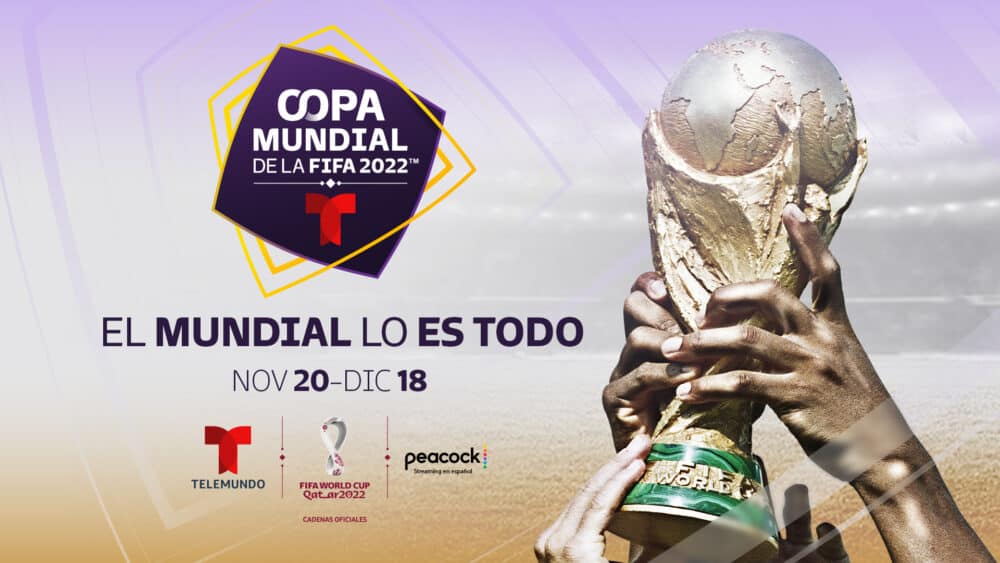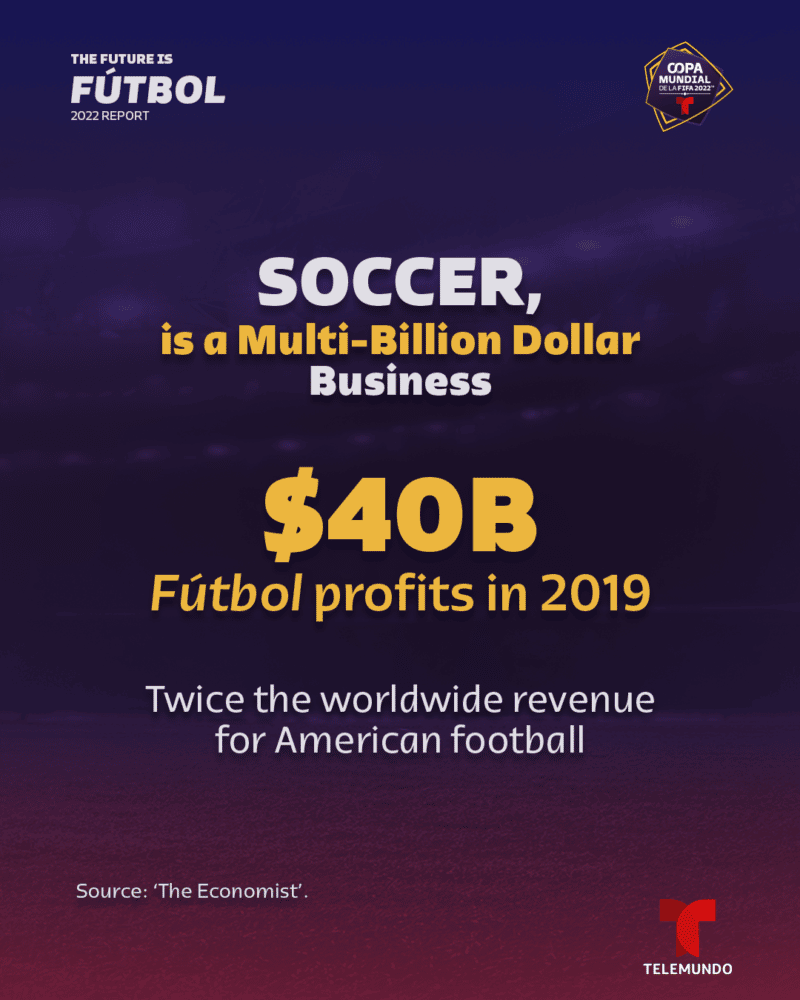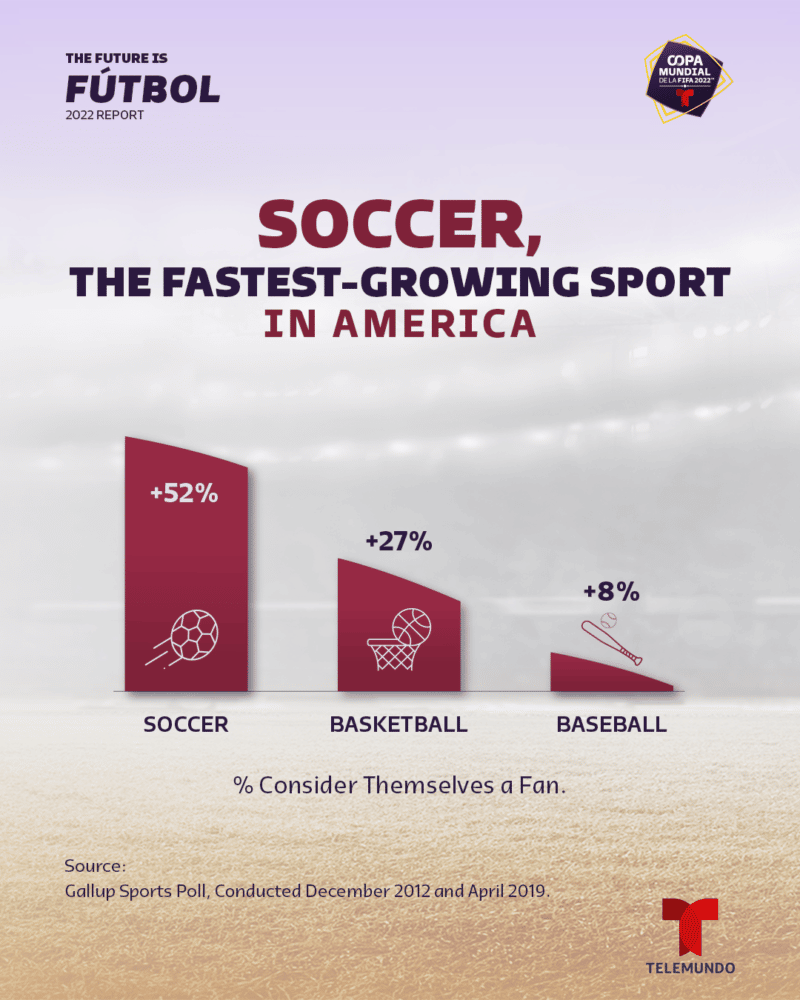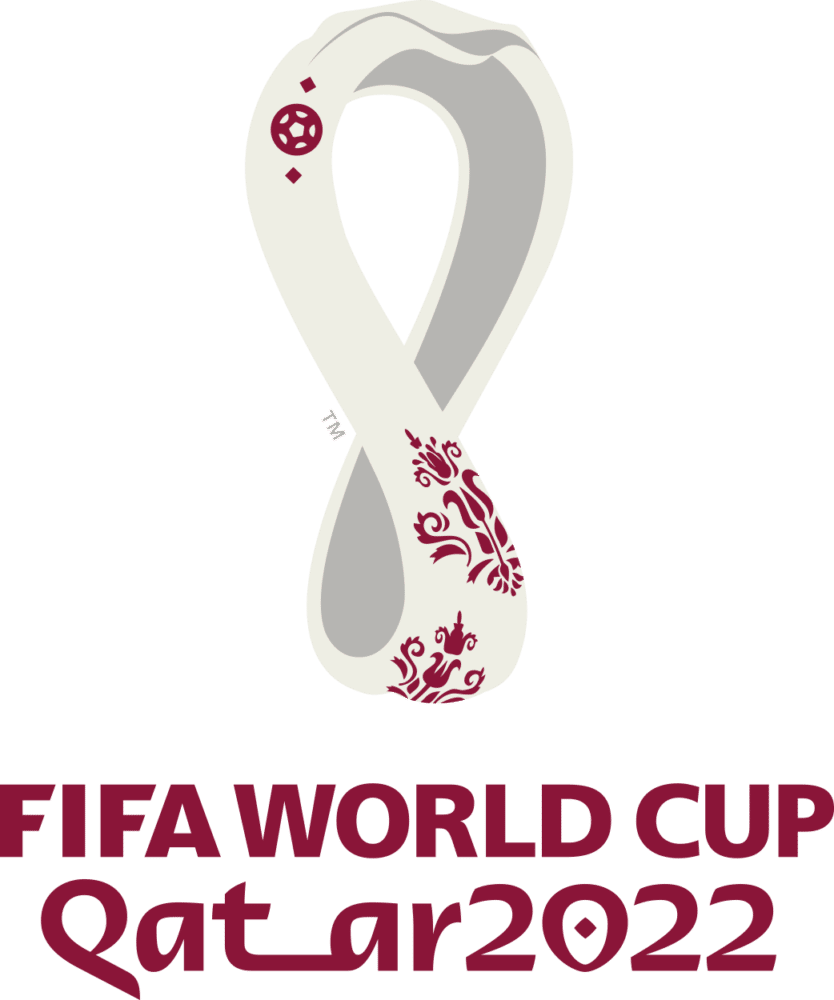
Latinos Are Fueling Soccer’s Growth as They Drive Many of America’s Demographic, Cultural and Political Trends
Telemundo Center in Miami, Florida, today released a proprietary, data-driven Telemundo Deportes report, The Future Is Fútbol (Football), revealing information and insights about FIFA World Cup 2022™, tournament viewers and the impact Latinos have on the game as players, clubs, national teams, and fans, changing the very fabric of American culture in the process. NBCUniversal Telemundo Enterprises choose the first day of the NFL season to announce their findings related to a fundamental shift in how soccer is perceived domestically, emphasizing the role the Spanish speaking player, fan, family, and soccer Mom, all play across American economics, politics and media. The deep dive look into the sport and the importance to the Latino communities as well as United States citizens both abroad and here in the U.S. used methodology drawn via primary and secondary research and data collection. Soccer is indeed an economic giant in the States as the report reveals, it was a multibillion-dollar business with profits of $40 billion in 2019, twice the worldwide revenue for American football. This is the year 2022 and those numbers are dated because of the NFL’s continued media growth led by Amazon Prime winning the rights to stream Thursday Night Football to their streamers along with the Sunday Ticket streaming package up for bid for a rumored $3 billion between Apple, Disney, Amazon and YouTube (Google) because AT&T is not bidding for a renewal. The Sports Techie community blog curator is half-Ecuadorian and I can attest to the amazing growth soccer has undergone over the past couple of decades because of the advancements in technology like the smartphone, tablets and OTT, together with the popularity of the U.S. Women’s Soccer Team and youth soccer, mixed in with the launch of the MLS and their rapid expansion. The latter in large part because of the massive business successes by top teams located in areas with large Latino communities I have lived in – Seattle, Los Angeles and here in Atlanta. To back that up, Fútbol has an estimated 5 billion fans around the globe and 85 million adult followers around the US. Group analytics company Gallup estimated that the sport has seen a significant increase in popularity, with a gain of 52% more fans from 2012 to 2019, compared to 27% growth in basketball and 8% growth in baseball during this period. This phenomenon is not by accident as the report indicates, noting for the primary data initiative, researchers relied on quantitative surveys, qualitative interviews with Enthusiasts and Superfans, and a state-of-the art neuroscience study with bilingual Hispanics using advanced technologies and science. Hispanic heritage month runs from September 15 to October 15 and leads into the World Cup starting on November 20 with the first match of the tournament slated to be Qatar versus Ecuador at Al Bayt Stadium. Viva Ecuador!
The Full Report is here.
“Fútbol is the sport of America’s future. Soccer is growing in the U.S. and Hispanics are clearly leading the way,” said Monica Gil, Chief Administrative and Marketing Officer, NBCUniversal Telemundo Enterprises. “Every four years, the FIFA World Cup TM brings Latinos and non-Latinos together with a spirit and intensity that no other sporting event in the world can match. There is no more authentic way to experience the World Cup than in Spanish. For companies and brands seeking real cultural connection and a space to engage Latinos, soccer and the FIFA World Cup TM are the place to be, this fall and for years to come.”

Methodology and Metrics
This research is about people who plan to watch the FIFA World Cup 2022™, referred to in the report as World Cup viewers. The report is fueled by its growing popularity among young people and women in particular, as well as Latinos overall.
The quantitative phase consisted of a national survey fielded among World Cup viewers ages 16 and older using a hybrid online and intercept in-person sampling framework to ensure representation of the hard-to-reach population. The sample consisted of 1,351 completed interviews among 967 Latinos and 384 non-Latinos, representative of soccer followers in the U.S. Estimates of soccer fandom and World Cup viewing were derived from a national pre-survey screener. Fieldwork was conducted in February 2022.
In the advanced neuroscience study conducted by the firm Neuro-Insight, fluent Latino bilinguals were the target because they could watch the game in Spanish or English. This study measured the activity in different brain regions responsible for guiding viewing behavior.
Metrics included the desire to watch certain content longer and the feeling of strong emotions during the experience. Bilingual Hispanics with similar demographics were divided into two groups to watch the same 2018 FIFA World Cup™ final (France vs. Croatia) match, with the only difference being the language of the broadcast.

The report makes light to the notion that the World Cup is considered more important among Hispanic World Cup viewers than any other sporting event, including the Super Bowl, the World Series, the Olympic Games, or the NBA Finals. FIFA reported that the 2018 FIFA World CupTM reached over half the global population with 3.57 billion viewers. In 2018, the World Cup had its greatest 32-day performance in Spanish-language media history, with a commanding total U.S. audience reach of 37 million.
Fans follow players and teams year-round as celebrities and representatives of national origin and sources of local pride. U.S. soccer fans spend 7% more than the average American sports fan on team sports clothing, tickets, sports equipment, and memorabilia. In 2021, soccer matches were available almost every day, with only six days without a match on broadcast TV, a phenomenon that offers brands, retailers and advertisers alike an advantage like no other sports property.
Other key themes highlighted in The Future Is Fútbol include:
Latinos Fueling Growth – Latinos have driven shifts in the U.S. population over the last decade. As their influence grows, so does soccer’s popularity. Hispanics and other diverse fans bring with them a love for soccer that has been part of their story for generations, shaped by history and now representing the next breakthrough in mainstream American sports.
- Among U.S. Latinos ages 16 and older, almost three-quarters (73%) say they are soccer fans, and three times more Hispanics call themselves Superfans (22%) compared to non-Hispanics (7%).
- More than half (53%) of Latinos ages 16 and older and nearly 1 out of 3 non-Latinos (29%) say they plan to watch the FIFA World Cup 2022.
- Latinos rank both soccer (57%) and American football (59%) well above basketball (45%) and baseball (40%).
“Fútbol is Everything” Culture
- 61% of Hispanic World Cup viewers are fútbol Enthusiasts, regular fans or superfans, who say that if their team won the World Cup, their euphoria would be unmatched, an experience more exciting than getting their dream job or getting married.
- Over half (57%) of Hispanic Enthusiasts say they have reshuffled their priorities to watch an important game, including skipping family or friend events, taken off work, spent money they did not have or traveled miles to watch an important match.
- The FIFA World CupTM is as big as a holiday. Soccer gatherings are momentous among Latino Enthusiasts who rank the event second only to Christmas, more significant than Thanksgiving and New Year’s.
Biggest Multi-Platform Sporting Event –The ability of fans to watch and engage on any screen has a monumental impact on the growing FIFA World Cup TM fandom. Soccer media coverage and content have increased exponentially to meet the demand for more high-quality live, virtual and social fan experiences 24/7.
- The FIFA World Cup 2022TM is expected to be the world’s biggest multi-platform sports event ever. The incremental viewership from live streaming helped make the 2018 FIFA World CupTM the biggest multi-platform sports event in Spanish-language history.
- 67% of Hispanic viewers plan to watch the World Cup on broadcast TV, and 42% plan to stream the matches.
- Television is the preferred device for Hispanics to watch the World Cup (90%), followed by smartphone (34%) and computer (17%).
The Power of Spanish – For most Hispanic fans, Spanish is the language and culture of fútbol. Viewers describe Spanish-language soccer commentators as excellent storytellers, utterly poetic and animated about what is happening on the field.
- Over half (56%) of U.S. Hispanic World Cup viewers prefer watching the FIFA World CupTM in Spanish.
- Even 1 out of 5 English-dominant Hispanic World Cup viewers prefer to watch in Spanish.
- Spanish is not exclusive to Hispanics because 17% of non-Latino tournament viewers said they would watch some of the matches in Spanish as well, an increase of 12% over 2018.
- According to a brain neuroscience study conducted among U.S. bilingual Hispanics, watching a World Cup match with Spanish commentary generated 15% greater likeability, keeping fans glued to their screens longer than watching the identical match in English.
- Key game moments, like the iconic goal call by the Spanish commentator, prompted an average of 37% greater emotional intensity compared to English, making the “highs” higher and the “lows” lower.
- The effects of Spanish game commentary also transferred to advertising. In the study, the identical ad, when played in Spanish had 19% higher likeability and 49% greater emotional intensity vs. English.
Latinas Are Watching and Bringing Their Kids – Hispanic women are an untapped opportunity among soccer viewers.
- Four in ten (41%) U.S. Latinas say they are likely to watch the FIFA World Cup 2022TM.
- 76% of Hispanic mom tournament viewers encourage their kids to follow the World Cup and professional fútbol.
- Hispanic females are passionate fans and together comprised 17 million Spanish-network FIFA World CupTM viewers in 2018, making the tournament the most-watched Latina sporting event in Spanish-language history.
- Among the World Cup audience, a fifth (21%) of Latinas call themselves Superfans, which is far greater than both non-Hispanic males (10%) and non-Hispanic females (8%).
- And Latino viewing is a family affair, with 70% of Latino parent event viewers saying it’s important to watch the FIFA World CupTM in Spanish with their kids.
First-Choice Sport of Young People in the U.S. – Soccer has become the fastest-growing major team sport among all high school students and is the most popular among Hispanic high schoolers.
- High school soccer participation increased 32% from 2002 to 2019, far more than the average growth of basketball (-6%), American football (-2%), baseball (6%), or ice hockey (7%).
- Soccer is egalitarian, considering that high school girls play almost as much as boys, with participation growing 31% for girls versus 33% for boys from 2002 to 2019. There were 394,105 high school girls who played soccer in 2019, a figure not far behind the 459,077 high school boys who played.
- Soccer is currently the most popular team sport among 40% of Hispanic high school students who say they played or were planning to play the sport in 2020, compared to 21% of all high school students.
Qatar 2022 Español Broadcast
Futbol will take center stage once again this Fall after four-years of men’s FIFA World Cup absence. The 2019 Women’s FIFA World Cup was last played in France. Because of the FIFA World Cup 2022TM return to North America and the U.S in 2026 co-hosted by Mexico and Canada, even more American growth is expected.
To meet the Hispanic demand, Telemundo Deportes (Sports) was granted exclusive Spanish-language rights to be the television home of the FIFA World Cup Qatar 2022TM from Nov. 20 to Dec. 18 in the nation of Qatar located in the Middle East.
The network is prepared to deliver the most ambitious coverage in Spanish-language history with all 64 matches live, including all four games on Thanksgiving Day. Peacock will stream live coverage of all matches on the new Tplus and will featured pre-game and post-game coverage. Fans can also look for special programming with extended interviews and highlights. Furthermore, parent company, Comcast, plans to unveil a dedicated 24/7 channel with exclusive content.

Sports Techie, the Spanish language loving American audience and the game’s passionate participants look forward to soccer winning over more supporters with each new generation.
Both Global and inclusive, growing across females and youth, fútbol is poised to taking the top spot with the American sports landscape, much like it is around the world. After years of wins, both large and small, fútbol is coming of age at the moment when millions of Latinos and fútbol fans of all backgrounds stand ready to watch, engage and lead the way.
My Dad’s roots are from Poland and they face off against Mexico, Argentina and Saudi Arabia in the group stage. My country’s National Team, Team USA, opens play against Iran.
My son Kellan is nine-years old and on the autism spectrum. He was diagnosed non-verbal by the Marcus Autism Center, however, I am happy to share that he is learning how to speak not only in English but in Spanish too, while he learns to play soccer.
Add that to the The Future Is Futbol, alongside VAR sports tech.
See you later sportstechie in Seattle, Atlanta and around the world!
Sports Techie Social Media Networks
Sports Techie Twitter: @SportsTechieNET: http://twitter.com/SportsTechieNET
THE #SportsTechie Twitter: @THESportsTechie: https://twitter.com/THESportsTechie
Sports Techie Facebook Fan Page: http://www.facebook.com/SportsTechie
Sports Techie YouTube Channel: http://www.youtube.com/user/sportstechie
Sports Techie LinkedIn Group: https://www.linkedin.com/groups/2958439/
Sports Techie LinkedIn (Robert Roble): https://www.linkedin.com/in/robertroble
Sports Techie Instagram: http://instagram.com/sportstechie
Sports Techie Pinterest: http://pinterest.com/SportsTechie/
Sports Techie Skyword: http://bobroble.skyword.com/
Sports Techie Snapchat, Skype: sportstechie
Sports Technology Podcast with Bob Roble.
Sports Techie Quora: https://www.quora.com/Bob-Roble
Sports Techie Moby Picture: http://www.mobypicture.com/user/sportstechieNET
Sports Techie Flickr: http://www.flickr.com/photos/86791607@N04/
Sports Techie Vimeo: https://vimeo.com/user36773456
Sports Techie Guy: https://twitter.com/sportstechieguy